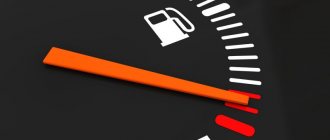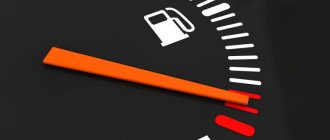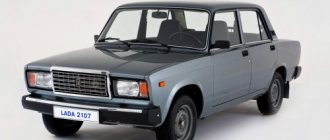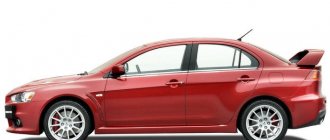10-14 6-9 VAZ
admin 09/13/2016
- VAZ-2109 1.1 carburetor Gasoline consumption VAZ-2109 1.1 carburetor per 100 km. Reviews
- Fuel consumption VAZ-2109 1.3 carburetor per 100 km. Reviews
- Fuel consumption rate VAZ-2109 1.5 carburetor per 100 km
- Reviews about fuel consumption of VAZ-2109 1.5 injector
- Real reviews about fuel consumption of VAZ-2109 1.6 injector per 100 km
The production of the five-door hatchback VAZ-2109 began in 1987, three years after the appearance of the three-door version of the VAZ-2108. These two cars became a completely unique phenomenon for the Soviet automobile industry - first of all, with their front-wheel drive layout, modern design at that time and an improved interior compared to previous Zhiguli models. The VAZ-2109 was more popular because the five-door design was more convenient than the three-door one.
The production of a car of this model continued until 2004 in the Russian Federation and until 2011 in Ukraine - here the VAZ-21093 version was assembled from vehicle kits supplied to the country by AvtoVAZ. Currently, this model is replaced in production by the VAZ-2114 model.
VAZ-2109 1.1 carburetor
The VAZ-21091 model was equipped with a derated carburetor four-cylinder VAZ-21081 engine with a volume of 1.1 liters. It developed a power of 54 hp. and a torque of 79 Nm at 3600 rpm. The engine was paired with a 4-speed manual transmission, but production of this model did not last long - until 1991, since the engine power was clearly not enough.
Gasoline consumption VAZ-2109 1.1 carburetor per 100 km. Reviews
- Yana, Odessa. My husband and I bought a VAZ-2109 with a 1.1 liter engine in 2013. At first we were surprised, we didn’t think there was such an engine, but it turned out that it was the original engine. The car was produced in 1990, but is in good condition and the engine is actually not as weak as it seems - there are four of us in the family plus a trailer - it drives fine. Consumption on the highway is about 5.5 liters, in the city – about 8.5 liters.
- Vladimir, Kozlovsk. The engine is not original - after mine burned out, I had to replace the engine. I couldn’t find a 1.5 liter one from my family, but through friends I managed to get a 1100 cm3 engine. What can I say about the dynamics - there is none at all, acceleration is generally slow, it does not accelerate more than 100 km/h at all. But in operation it is quiet and economical - 8 liters in the city, 5.5-6.0 liters on the highway.
What is the real gasoline consumption on a carburetor VAZ 2109
It is officially believed that fuel consumption per 100 km when using a carburetor on this car model is on average equal to the following indicators:
- City mode - 8.2 liters;
- Driving on the highway - 5.4 liters.
That is, the manufacturer initially developed this option for long trips over long distances, where it was possible to really save on every 100 km of travel. The question is: do these data correspond to the real indicators that were recorded by ordinary car owners?
VAZ-2109 1.3 carburetor
The base engine for the VAZ-2109 was the VAZ-2108 engine. This is an inline four-cylinder carburetor engine with a volume of 1289 cm3 and a power of 64 hp. and with a torque of 94 Nm. Initially, the engine was equipped with a 4-speed manual transmission, but later a more efficient 5-speed gearbox was installed for it. The model with this engine was in production until 1997.
Also produced in a small series was the VAZ-2109-91 model, equipped with a 1309 cm3 rotary piston engine. This engine developed a record 140 hp for that time. and a torque of 186 Nm, but it was too unreliable and whimsical, so production was curtailed in the early 1990s.
Fuel consumption VAZ-2109 1.3 carburetor per 100 km. Reviews
- Dmitry, Pavlodar. Before my “nine” I had a “kopeck”. After that I wanted to buy a foreign car, but for the amount I had, I could only buy a piece of shit that was trashed. I found a car made in 2000, with a 1.3 liter carburetor. What can I say - I started repairing it literally 30 minutes after purchase, because the battery died. On the highway the consumption is about 7 liters, in the city – at least 8.5-9.0 liters.
- Oleg, Novosibirsk. I bought a “nine” from a friend in 2011. She stood in the garage for almost three years, did not leave and did not start. He discounted it at a normal price, I took it for service and the master said that it was in export configuration - that’s why it was preserved in normal condition, even though it was manufactured in 1993. I did the repairs and after that it started working like clockwork. It starts with half a turn, consumption in the city is 7.5 liters, on the highway generally 5.5 liters. They’ve already offered to buy it more than once or twice, but for now I’ll go on my own.
- Mikhail, Khanty-Mansiysk. I bought the car back in 2006 – and it was hard to call it a car. The box was completely destroyed, the engine was generally in the trunk, I’m generally silent about the wiring and everything else. But the body was in excellent condition, only the wings were overcooked. I completely silenced it, gave the engine a major overhaul, and replaced the gearbox with a five-speed gearbox - by the way, a 5-speed manual transmission is completely useless for it, because... It still doesn’t go more than 130 km/h. But for the city it will do - consumption is about 8 liters, on the highway 6.5.
- Denis, Omby. VAZ-2109, engine 1.3 carburetor, 1994 The car was purchased in 2000, in 2005 I took it for myself after the death of my father. Of course, it has undergone a lot of repairs, but overall the car is not bad - it has soul. Gasoline consumption in the city is 10 liters, on the highway 7 liters, but I like to press on the gas - if I drove more calmly, then the consumption would of course be lower.
Other cars: Geely MK 1.5 fuel consumption reviews
VAZ-2109 1.5 carburetor
In 1988, production of the VAZ-21093 model began, equipped with a VAZ-21083 four-cylinder carburetor engine. This engine developed a power of 68 hp. and at 3400 rpm it achieved a torque of 104 Nm. This model was in production until 2006, until it was completely replaced by versions with injection engines.
For the VAZ-21093, the engine was paired only with a 5-speed gearbox, which made it possible to achieve significant fuel savings, especially when driving outside the city.
Fuel consumption rate VAZ-2109 1.5 carburetor per 100 km
- Alexey, Barnaul. Before my “nine” with a 1.5 engine, I had the same one, but with a 1.3 liter engine. So, in terms of dynamics, the one and a half car is much more interesting, although the difference in power is only a couple of horses, but it turns much more fun. Well, in terms of consumption, the maximum I could get in the city was 10-11 liters in winter, but on the highway you can safely invest 6 liters.
- Ivan, Irkutsk. I took my “nine” in 2009. Why the “nine” - for my budget they decided to take it better than a foreign car that was trashed. She served me for about six years - after that my dear was so tired that she simply refused to ride. Well, this is not surprising, because the car is from 1996, and more than 10 years is a long time for our automobile industry. Although, in principle, the machine is unpretentious, and the average consumption was 8 liters - for a 1.5 liter carburetor this is not so much.
- Vladimir, Krasnoyarsk. The purchase of the VAZ-2109 was due to numerous advice in the style of “it’s better to buy a domestic car than an imported bucket of bolts for the same money.” I don’t know what the condition of the imported bucket is, but the belching of the domestic auto industry after a closer acquaintance (and I completely disassembled it) is terrible. The engine is mounted on one cushion, the whole body is rotten, the seats are different from each other - and that’s not all. The only plus is the consumption of 9 liters in the city.
- Denis, Novosibirsk. I drive a 1997 Nine. One of the last ones to be produced with a carburetor. I bought the car in 2013, with a mileage of almost 200 thousand km. Yes, it needs to be repaired - but this is done simply and without hemorrhoids, and spare parts cost 10 rubles a bucket, unlike foreign cars. Consumption on the highway is 7 liters, in the city from 9 to 11 liters - depending on how you load it.
- Arsen, Arzamas. My first car - I bought it for 90 thousand rubles in 2006. I drove it for 2 years, it started to rust and rot, half of the components fell off, even though the car was 1996. On the plus side, you can easily fill up with 92 gasoline, and consumption in the city is up to 10 liters.
- Anton, St. Petersburg. VAZ-21093, -1996, complete stuffing (wheels, high panel, heated seats, electric windows). At the time of purchase - and this was 2005 - it was cool! Compared to the “six”, the car is much better - the suspension is softer, the gears are longer and you can safely go 120 km/h on the highway. I used A-92 gasoline and drove without problems with a consumption of about 10-11 liters in St. Petersburg.
- Kirill, Barnaul. The first car, I repaired it a lot and for a long time - but this is probably how it should be, so after three years of ownership I began to quickly understand cars. In general, I’m happy with everything, the consumption is on average 8 liters per hundred square meters, and you can even pour A-80 without any problems if you’re really tight on money.
- Alexander, Feodosia. I bought the car from a guy who had it in his garage for 5 years. Despite the fact that the owner treated the car well, this is still a domestic auto industry. The interior is uncomfortable, everything creaks and cracks, the electrics constantly short out, the body probably begins to rot right as the car leaves the workshop. And the consumption is 9-10 liters on this trough, which practically does not move... In general, I drove it for a year and sold it to hell.
Other cars: Renault Simbol fuel consumption
VAZ-2109 1.5 injector
Since 1998, serial production of the VAZ-21093i model began, equipped with a VAZ-2111-80 injection four-cylinder engine with a power of 74 hp. and with a torque of 118 Nm. Compared to carburetor engines, injection engines not only developed higher power and torque, but also had better elasticity at low speeds and were more economical. These engines were also offered with a 5-speed manual transmission.
Reviews about fuel consumption of VAZ-2109 1.5 injector
- Alexey, Tomsk. I wanted a car since I was 18 years old, but naturally there was simply no money for it. Then the car appeared, but another problem arose - I needed a working car, so that killing would not be a pity and would be inexpensive at the same time. I decided to take the injection “nine” 2002. Her condition was more or less - well, what condition can a ten-year-old VAZ have? In principle, it justified itself - spare parts are inexpensive, you don’t mind killing it, and gasoline consumption is 10 liters per 100 km in the city, an injector after all.
- Alexander, Barnaul. VAZ-21093, 2002, 1.5 injector. Purchased with a mileage of 120 thousand km. Everything that could possibly creak in it creaked, and probably even more. There were a lot of mistakes, everything had to be done constantly, but for the money that I paid, I shouldn’t have expected anything else. But low fuel consumption - up to 8 in the city and up to 7 on the highway, as well as the ease of repair and low cost of spare parts compensate for many shortcomings.
- Kirill, Abakan. I bought a “nine” in 2014. The car was produced in 2003, with a one and a half liter injection engine. I bought it when I was a student - what else did I need? The condition is normal, the owner himself admitted that one wing was broken, but it was made very well. At the same time, the luxury package is another plus. Well, efficiency - in winter the maximum reaches 11 liters, in summer about 9, on the highway it depends on the speed - from 6 to 7 liters.
- Denis, Yekaterinburg. I learned to drive in my father’s service VAZ-2109, with a carburetor. In my second year at university, I managed to save some money and buy my own “nine”, but I bought it with an injector - it’s faster than with a carb, and its consumption is lower. In the city I drove consistently 50-70 km/h, consumption was up to 8.5 liters per 100 km, on the highway - no more than 120 km/h, consumption was accordingly about 7 liters.
- Vasily, Ufa. In general, I have a Toyota Corona, but I drive a VAZ-2109 in my free time. I actually bought it by accident - at a gas station I saw a car with an advertisement on the rear window, talked to the owner and bought it. She was in good condition, the car was well maintained, the engine was tuned for maximum efficiency. Believe it or not, in the city 10 liters is enough for me for 130 km, i.e. consumption is around 6.5-7.0 liters per 100 km.
- Grigory, Sergiev Posad. VAZ-21093i, 2001. When purchasing, the budget was 100 thousand rubles - not much, but true. Naturally, I chose only the domestic auto industry, I didn’t even look at foreign cars. In principle, “nine” is the cheapest and most practical option. Yes, you have to tinker with it, but the spare parts are inexpensive, repairs are also simple and can be done in the garage, and the fuel consumption of 8 liters in the city is quite low and no worse than that of many foreign cars.
- Pavel, Moscow. "Nine" 1999. My faithful student car, in which I honestly drove throughout my studies at the university, transported a bunch of girls and my future wife. What else does a student need - consumption in Moscow is a maximum of 10 liters with traffic jams, comfort is not so great, but it is there, spare parts are cheap and you can easily repair it on your own with your dad and you.
Other cars: Honda Accord fuel consumption reviews
What causes high fuel consumption on the VAZ-2109
Setting up the ignition of a VAZ 2109 carburetor without a strobe light
The reasons are mainly as follows:
The carburetor air damper is not open enough. When the motor is running, this mechanism is carefully closed and in a vertical position. In this case, the “choke” handle should be pulled out towards you. If the damper is slightly open, it causes a malfunction. In this case, gasoline is consumed in large quantities, and the volume of air that enters the fuel mixture decreases. To solve this problem, some owners close the carburetor air damper, thereby enriching the fuel mixture. However, this threatens to increase fuel consumption several times. It is better to adjust the air damper drive, and then the problem will be partially solved.
The fuel nozzle holder is not installed tightly enough. With this problem, the fuel mixture enters the cold running system, bypassing the fuel nozzle. This leads to fuel entering the cylinders not only at idle, but also in any mode. To fix this problem, you need to check the tightness of the holder. Over-tightening is not allowed because this may cause deformation.
You need to tighten it carefully, but at the same time so that the holder can twist itself out from vibration. On a carburetor with a solenoid valve, you need to check how well it functions
On the motor you need to remove the plug and put on the wire. If the valve is working properly, then shut off the fuel supply by turning the housing clockwise. Lack of tightness of the needle valve of the float chamber. With this problem, excess gasoline enters the float chamber and then into the engine cylinders. This often occurs if the needle valve is faulty. In this case, you need to check the tightness of the device. This procedure is described in any instructions or manual for using the car, so it will not be difficult to perform. It is advisable to replace the needle valve if this problem occurs. There is no point in repairing, since you will have to pay more for repairs than for a new mechanism. There are fuel jets for the main metering system. In such a situation, the fuel becomes over-enriched. Here you need to check the markings of the jets. This is a rather complicated procedure, so it is better to ask specialists for help. The jets are too clogged. This is a fairly common reason, which is absolutely easy to solve. You need to clean the jets by removing the carburetor cover. This can also be done without removal, but in this case you will have to spend a lot of time and effort. Malfunction in the forced idle economizer. The solenoid valve or other system mechanism may be faulty here. This usually occurs due to rough idling of the engine. You need to check the system and troubleshoot problems. The engine filter is clogged. The fuel mixture is greatly enriched in fuel as air enters it through the filter element. It is necessary to clean the clogged elements, and then the problem will be eliminated. This must be done carefully so as not to damage anything.
It should be noted that too much fuel can be consumed not only due to problems with the carburetor.
- faulty motor or injector;
- problem with engine thermal conditions;
- the ignition timing is incorrectly set;
- lack of tightness of fuel system elements. In this case, gasoline simply flows out of the gas tank;
- The car wheels do not release the brakes well. This is the most common reason for fuel consumption. This happens due to the fact that the rolling resistance of the machine increases;
- Wheel bearings that are too tight. In this case, the resistance to movement of the vehicle increases, resulting in fuel consumption;
- low tire pressure. This can be checked using a pressure gauge;
- wheel mounting angles are broken;
- problems with spark plugs;
- problems with the centrifugal and vacuum regulators.
As we can see, there are quite a few reasons for the high fuel consumption of the VAZ-2109. In order to find out what exactly caused the loss of gasoline, you need to understand your car very well and thoroughly know the design of the vehicle. If you find it difficult to determine and eliminate the causes of a malfunction, then you can always contact a technical service, where this problem will be quickly resolved. From time to time, the car must be shown to specialists so that it functions properly for a long time and does not require frequent repairs.
VAZ-2109 1.6 injector
In 2001, the VAZ-210934-20 model appeared. As a power unit, it uses an injection four-cylinder 8-valve VAZ-11183-20 engine with a volume of 1596 cm3. It produces 81 hp. and a torque of 120 Nm and is combined with a 5-speed manual transmission.
Real reviews about fuel consumption of VAZ-2109 1.6 injector per 100 km
- Evgeniy, Ekaterinburg. I’ll say right away that I bought the car to drive. There is nothing native left in her anymore. The engine is 1.6 liters and that friend rebuilt and rebuilt it for me, it now produces more than 100 horses. Consumption, of course, has also increased - in the city it’s about 14 liters, if you drive calmly it’s about 10 liters. But I like it and do everything at the traffic light.
- Ilya, Samara. After I got my license in 2005, I had exclusively domestic cars for almost 8 years. The latest from our automobile industry is VAZ-210934-20, with a 1.6 liter injection engine. The car was produced in 2001, it has covered 150 thousand in 10 years. After the purchase, the engine, suspension and everything else were overhauled - the rest did not cause problems. I’ll tell you, the car is reliable and unpretentious, if you look after it, and it’s also economical - in the city it’s never been more than 9 liters, on the highway it’s about 5 liters in general.
- Denis, Anzhero-Sudzhensk. I bought a car from my father - he still saved up the money to switch to a foreign car, but I got my own car. Its main feature is the engine, 1600 cubes. Consumption in the city is about 10 liters, well, for any car with such an engine it is almost identical. I drove it for a year and a half and decided that it was expensive to refuel with gasoline - I installed an LPG system. Consumption has increased, but this is also because I stopped saving - now in the city I have a stable 12-13 liters, but given the price of gas, this doesn’t bother me at all.
- Kirill, Barnaul. I don’t care about those who criticize the domestic auto industry. Yes, it may be inferior in quality and reliability to foreign cars, but it is also much cheaper to buy and to operate. And if your arms are straight, then everything will be fine. I bought it with a mileage of 150 thousand - I only replaced the chassis, pump and cooling fan. The timing belt was changed at 175,000 km!!! The 1.6 liter engine performs very well, the brain did not float at all. And also economical - in mixed mode it never produced more than 7.5 liters.
- Timofey, Sergiev Posad. "Nine" with a 1.6 liter injector, 2003. Before it there was a “five” - when I changed, it seemed like I was driving a foreign car. Consumption up to 12 in the city and 7 on the highway, I adjusted everything to suit myself - in general, it didn’t bother me at all for 3 years (although I still did minor repairs). Now I’m thinking of selling and buying a Skoda.
- Vasily, Krasnoozerskoe. VAZ is a VAZ. You always know what to expect from him, you know that even with serious repairs you will be able to support him financially. And it carries its rear just like a foreign car. The downside is the constant noise in the cabin, everything creaks and rattles. Consumption on the highway is about 7.5 liters, in the city 10 liters.
Fuel consumption VAZ 2107, carburetor
How to reduce gasoline consumption in a car
The Russian flagship of the automotive industry has produced four types of “carburetor” cars with different engine sizes in liters (1.2, 1.3, 1.5 and 1.6). And their fuel consumption is different.
The first two models are initially economical, as they produce less fuel due to their size, but are less accepted by the population due to their low power.
1.5 engine gives output:
• outside the city - 6.8 l/100 km; • in the city - 9.6 l/100 km.
"Seven" with a 1.6 liter engine. consumes:
• outside the city - 6.9 l/100 km; • in the city - 10.2 l/100 km.
The pattern is clearly visible: the larger the engine, the more voracious it is. It should also be noted that the VAZ 2107 carburetor, which has a four-speed gearbox, consumes fuel more actively than a car with a five-speed gearbox.











